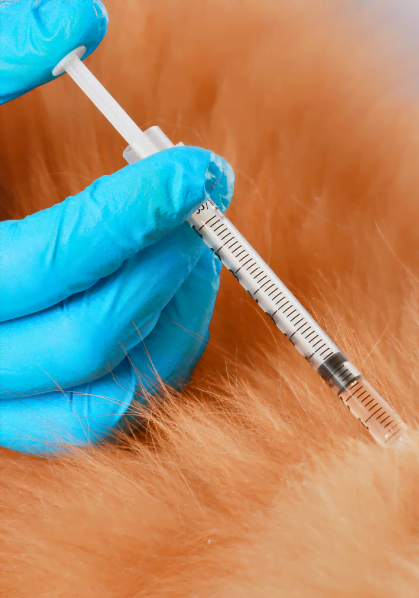
Presented in collaboration with Purina® Pro Plan®
Diabetes is a fairly common disease in cats, often diagnosed between the ages of 8 and 13. We regularly take in diabetic cats at the shelter and, unfortunately, this poorly understood disease is often a barrier to adoption. Yet, affected cats can have a life expectancy and quality of life comparable to those of non-diabetic cats if their condition is well managed.
What is diabetes?
The short answer is that diabetes is a metabolic inability to regulate glycemia, i.e. blood glucose (sugar) levels.
Glycemia is essentially regulated by insulin, a hormone naturally produced by the body. However, a diabetic cat doesn’t produce enough insulin, or their body is unable to use it properly. The result is hyperglycemia, i.e. abnormally high blood-sugar levels. Stable glycemia is essential for the body to function properly.
Diabetes management
If your cat has recently been diagnosed with diabetes, your veterinarian will give you all the information you need on how to care for your cat, how to administer insulin and how to measure blood-sugar levels. Most cats need a dose of insulin every 12 hours.
It’s crucial to follow your vet’s recommendations, as your cat’s needs are not necessarily the same as another diabetic cat. Initially, you may need more frequent visits to the clinic to establish the insulin dose required for your companion. Following this, visits will be needed less frequently. Eventually, your cat will simply need regular monitoring like any other companion animal, either once a year or twice a year for older cats.
Diabetic cats need a diet adapted to their condition. Your veterinarian will be able to recommend canned or dry food formulas, as well as determining with you the amount of food and frequency of meals.
Regular exercise also helps manage diabetes and weight, as well as improving Kitty’s psychological well-being. Encourage them to stay active every day. Playing with your cat is also a great way to strengthen your bond with them!
Will I have to give my cat insulin injections?

Your cat will probably need insulin injections, at least at the start of treatment. Although the word injection can be frightening, insulin administration is simpler than you might think. Often, it’s easier to inject insulin into a cat than to make them swallow a pill!
You don’t need to be an animal health professional to do it, either: the injection goes under the skin using a fine needle or an injector pen, and there’s no need to search meticulously for a vein. Your veterinary team will show you how. To make things easier, we recommend that you always make this process pleasant for the cat using positive reinforcement. Your kitty will soon get used to it!
Is it incurable?
Diabetes is incurable, but if treated early and rigorously, your cat may no longer need insulin. This is called remission. If this is the case, however, they will need to maintain their special diet and receive appropriate medical follow-up.
Although there is no cure, there are treatments available to manage feline diabetes, and when it is well controlled, your cat can enjoy a fulfilling life. Remember, it is absolutely necessary to treat diabetes. Without proper care, a diabetic cat will die.
Budget
Of course, medical treatment comes at a cost. So it’s wise to budget for your diabetic cat’s care. However, if your cat had health insurance prior to the diagnosis, the treatment will often be covered.
It’s very difficult to estimate the costs involved in treating diabetes, as each patient has specific needs. Things to consider include:
- Special food for diabetic cats
- More frequent medical check-ups during the first year, including blood and urine tests
- Insulin
The Association des médecins vétérinaires du Québec estimates that it costs an average of $127 per month to care for a healthy adult cat. In comparison, a diabetic cat could cost you between $200 and $250 a month.
Living with a diabetic cat
It’s quite possible for you and your diabetic cat to lead a good life, as long as you stick to the golden rule: routine! A diabetic cat will need to receive their meals and insulin doses at regular times (usually every 12 hours).
It’s a good idea to ask yourself the following questions:
- Do I have a sufficiently routine lifestyle?
- Am I alone, or are there other people in the household who can provide care?
- Do I have the energy to provide daily care and regular medical follow-up?
- Do my finances allow for this care?
- Are there people around me who can support me if need be, or do I have access to day-care services or home visits?
Your cat’s illness can also be an opportunity to strengthen ties with your community. Leave a key with a neighbour or friend who lives nearby and show them how to administer insulin to your cat. This could come in very handy in case of unforeseen circumstances or when you go on vacation.
Symptoms of feline diabetes
Cats are usually diagnosed with diabetes when their guardians notice abnormalities in their behaviour or appearance. Signs to look out for include:
- Increased thirst and urine production
- Increased appetite
- Unexplained weight loss
- Plantigrade stance (see image)
- Lethargy or apathy
- A dull, unkempt coat
Of course, you can’t determine whether your cat is diabetic simply by observing these symptoms. The diagnosis can only be made by a veterinarian, following an examination and laboratory tests, so don’t hesitate to consult your vet if you’ve noticed these symptoms or if you’re concerned about your cat’s condition.

Predisposition to diabetes
Some cats are more likely than others to develop diabetes. Here are some risk factors:
- Obesity (the risk is multiplied fourfold)
- Genetics (certain breeds are more often affected, such as the Tonkinese, Norwegian and Burmese)
- Certain medications
- Pancreatic disorders
Signs to watch out for in a diabetic cat
If your diabetic cat refuses to eat more than two meals in a row or if their symptoms change or worsen, contact your vet immediately. Your cat’s insulin dose may need to be adjusted.
Likewise, if your cat receives too much insulin, their blood sugar levels will fall and they will experience hypoglycemia. Trembling, loss of appetite or greatly increased appetite, agitation, disorientation, convulsions and loss of consciousness are just some of the signs of abnormally low blood sugar. To treat a possible hypoglycemic attack, always have a source of glucose, such as corn syrup, on hand. Your vet will be able to advise you on what to do in the event of hypoglycemia.
As you care for an animal living with a chronic illness, your relationship with them may deepen and your attachment intensify. Over time, your sense of observation will sharpen, and you’ll find it easier to understand your cat’s needs. And your cat will be forever grateful...
Should I adopt or foster a diabetic cat?
Taking care of a diabetic cat isn’t for everyone, but if your lifestyle allows it and you want to give a second chance to an animal in need, you might consider adoption. Diabetic cats who end up in shelters often remain there for several weeks, even months, waiting for a caring family.
If you’re on the fence about adopting a cat with diabetes, fostering may help you get a feel for what it’s like to care for such an animal.
Come and meet our residents during the shelter’s opening hours and talk to our team!







